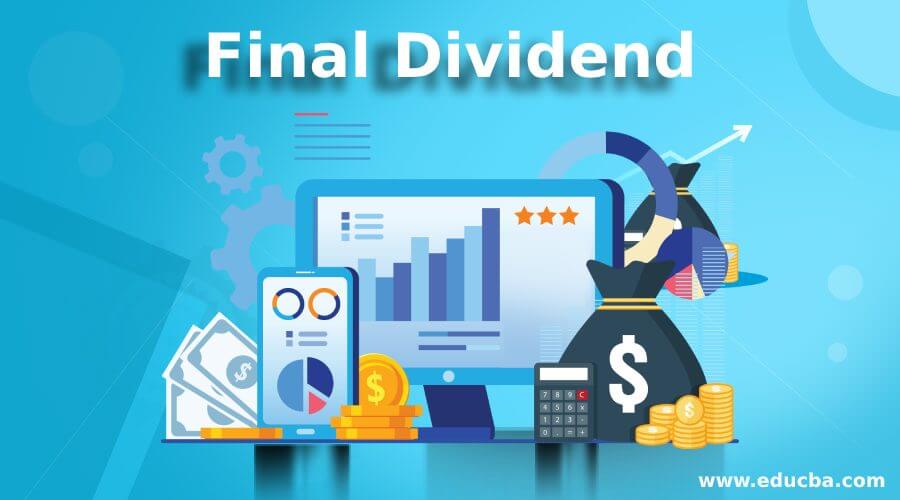Updated July 19, 2023

Introduction to Final Dividend
The company distributes the final dividend, which represents a proportion of the earned profit, among its shareholders. It is generally announced during an annual general meeting of the company for a specific given fiscal year. It is announced only after finalizing, auditing, releasing the period-ending financial statements, and informing the directors.
Explanation of Final Dividend
Final dividends are indeed announced after finalizing, auditing, and releasing the books of accounts, which is different from interim dividends. The decision to declare a final dividend is based on factors such as the financial health and profitability of the company. The management decides the percentage of profit to distribute among shareholders as the final dividend based on the company’s profitability, and the directors are aware of it.
It involves a large form of payment given to a company’s shareholders. Based on the firm’s profitability for the fiscal year, corporate directors or management typically declare final dividends during the annual general meeting.
It is usually more substantial as it represents the company’s final distribution of profits for a particular fiscal year. Thus, the final dividend and liquidating dividend are two different things.
Features
The features are as follows:
- It depends a lot on the business’s final profitability and financial health.
- It is generally larger than the interim dividends announced.
- It is related to the company’s financial performance for the full fiscal year.
- A final dividend, once declared, cannot be canceled, unlike an interim dividend.
Example
Let us take an example of a company called ABC Ltd., for which a shareholder holds 1000 shares, and in the same year; the company announced a dividend payout of $2 per share due to the profitability it has made in the year. Thus, the shareholder holding 1000 shares will get a payout of 1000* $2 = $2000 as a one-time dividend amount for the year. The company cannot cancel the final dividend once announced under any circumstances; otherwise, it is liable to compensate the shareholders with interest charges. Once the company announces the final dividend, it must release the payment within 30 days of reporting the news.
Final Dividend Accounting Treatment
Dividends, be it any interim if received, will be shown on the income side of the Profit and Loss statement. Dividend, be they interim or final if paid, is generally deducted from the reserves and surplus of the balance sheet. On the date when the board of directors declares the dividend, the shareholder’s equity account where we have the retained earnings is debited for the overall dividend amount which has been declared and the management is going to pay. In the current liability account, the section with the dividend payable is credited with the same amount as above. On this date, the current liability account, where we had earlier, the dividend payable section, will get debited now, and the asset account cash section will get credited.
Difference Between Interim Dividend and Final Dividend
The difference is as follows:
- The board of directors announces the interim dividend, whereas shareholders declare the final dividend in the annual general meeting.
- The company announces the interim dividend before the finalization or audit of its books of accounts.
- The interim dividend is typically related to a six-month period (half year), while the final dividend pertains to the entire fiscal year.
- The interim dividend announced does not tentatively become an obligation due from the firm to its shareholders. In contrast, the final dividend announced immediately becomes an obligation due from the firm to its shareholders.
Advantages and Disadvantages
Below are the advantages and disadvantages:
Advantages
Some of the advantages are:
- It is more significant than interim dividends, which are profitable to company shareholders.
- A company issuing a dividend gets a lot of confidence from the shareholder side as they perceive the company as a value-generating firm.
- It shows the stability part of the company; investors will therefore be eager to put money into such companies.
- The shareholders utilize the temporary excess cash earned by the firm as the distribution of the profit earned.
Disadvantages
Some of the disadvantages are:
- Once announced, it cannot be canceled, which is possible in the case of an interim dividend.
- It is a larger payout for the company than the interim dividend, which means sharing the profit on a larger scale.
- This reduces the retained earning to a larger scale than the interim dividend.
- It limits the company’s growth by reducing usable cash’s sum or value.
Conclusion
As discussed above, we found how the final dividend differs from the interim dividend. Also, we could see the pros and cons of issuing a final dividend and how it benefits the company and the shareholders. To sum up, final dividends are always a good approach by the company for the shareholders, which motivates them to have invested their hard-earned money.
Recommended Articles
We hope that this EDUCBA information on “Final Dividend” was beneficial to you. You can view EDUCBA’s recommended articles for more information.

